Knitting designs are blueprints guiding the creation of fabric using yarn and needles, offering patterns and step-by-step instructions for crafting various textiles, from clothing to home decor, ensuring clarity and creativity for all skill levels.
1.1 What Are Knitting Designs?
Knitting designs are detailed plans or patterns that guide the creation of knitted items, such as clothing, accessories, or home decor. They typically include step-by-step instructions, stitch diagrams, and material lists to help crafters bring the design to life. These designs can range from simple scarves to complex sweaters, offering versatility for knitters of all skill levels. By providing clear guidance, knitting designs make it easier for individuals to create professional-looking projects, ensuring consistency and accuracy. They serve as creative blueprints, combining artistic vision with practical instructions to produce beautiful and functional textiles.
1.2 Importance of Instructions in Knitting
Clear instructions are essential in knitting, ensuring projects are completed accurately and efficiently. They provide step-by-step guidance, helping knitters understand complex stitches and techniques. Without proper instructions, mistakes can occur, leading to frustration and wasted materials. Detailed patterns also help maintain consistency, ensuring the final product matches the intended design. For beginners, instructions build confidence and skills, while experienced knitters rely on them for precision and creativity. Well-written instructions enhance the knitting experience, making it more enjoyable and rewarding. They are the foundation of successful knitting, transforming yarn into beautiful, functional, and lasting creations.
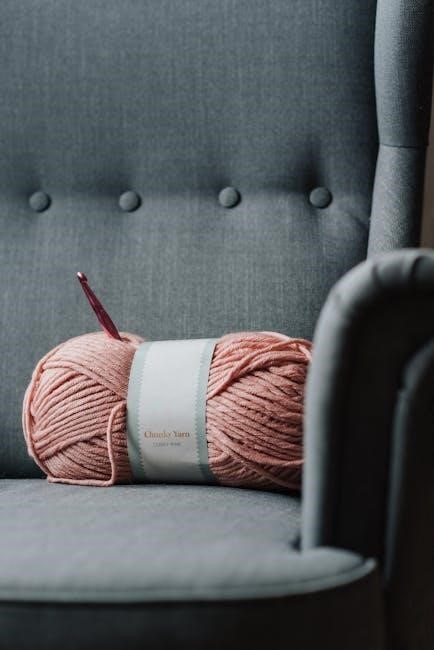
Types of Knitting Patterns
Knitting patterns vary widely, from clothing and accessories to home decor and specialty designs, offering diverse options for creators to explore their creativity and skill levels.
2.1 Clothing and Accessories
Clothing and accessories are among the most popular knitting patterns, offering a wide range of designs for sweaters, scarves, hats, and more. These patterns cater to all skill levels, from simple beginner projects like cozy scarves to intricate sweaters with complex stitches. Accessories such as gloves, socks, and shawls provide endless creativity. Many patterns include detailed instructions, ensuring clarity for even the most challenging designs. With options for customization, knitters can choose yarn types, colors, and sizes to create unique pieces. Perfect for personal use or as gifts, these patterns make knitting practical and rewarding, combining style with functionality.
2.2 Home Decor Patterns
Home decor knitting patterns offer creative ways to enhance your living space with handmade items. From cozy blankets and pillow covers to intricate table runners, these designs add warmth and style. Patterns often include step-by-step instructions for creating textured cushions, delicate lace curtains, or sturdy rugs. Customization options allow knitters to choose yarn colors and sizes to match their home decor. These projects are perfect for beginners and experienced knitters alike, providing practical and beautiful results. Knitting home decor items is a rewarding way to personalize your space while enjoying the therapeutic benefits of knitting.
2.3 Specialty Knitting Designs
Specialty knitting designs cater to unique needs and interests, offering intricate patterns for items like amigurumi toys, seasonal decorations, and custom gifts. These designs often feature detailed instructions for complex stitches or motifs, ensuring precise results. They may include themes like holiday-specific patterns, baby items, or pet accessories. Patterns are tailored for various skill levels, from beginner-friendly projects to challenging designs for advanced knitters. Specialty knitting allows creators to express their individuality, crafting one-of-a-kind pieces that stand out. These designs inspire creativity and provide a sense of accomplishment, making them a favorite among knitting enthusiasts seeking something extraordinary.
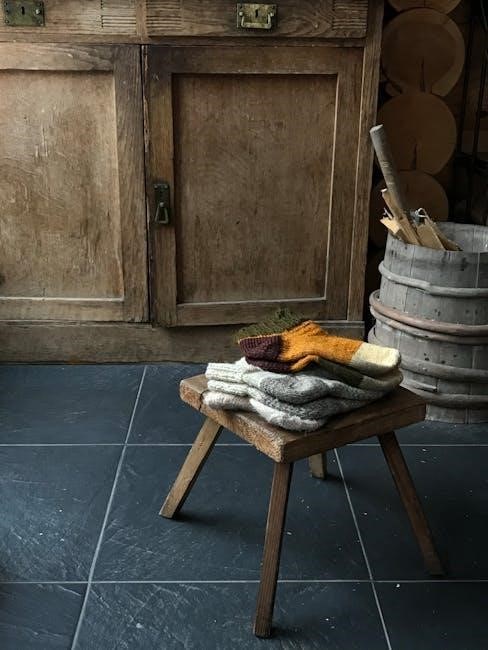
Knitting Techniques
Knitting techniques range from basic stitches like garter and stockinette to advanced methods such as cables and Fair Isle knitting, enabling the creation of diverse textures and patterns.
3.1 Basic Knitting Stitches
Mastering basic knitting stitches is essential for any beginner. The garter stitch, created by knitting every stitch, is the simplest and most textured. The stockinette stitch, worked by knitting one row and purling the next, creates a smooth fabric. These stitches form the foundation for more complex patterns, allowing knitters to build confidence and skill. Clear instructions and tutorials guide learners through each step, ensuring a strong understanding of the fundamentals. Practicing these stitches helps develop muscle memory, making it easier to progress to advanced techniques and explore various knitting designs effectively.
3.2 Advanced Knitting Techniques
Advanced knitting techniques expand creative possibilities, offering intricate designs for experienced knitters. Cable knitting involves crossing stitches to create textured patterns, while Fair Isle and intarsia enable vibrant colorwork. Lace knitting uses yarn overs and decreases for delicate, openwork fabrics. Shaping techniques, like raglan sleeves and seaming, allow for tailored garments. These methods require precision but unlock complex projects. Step-by-step instructions and video tutorials guide knitters through challenging stitches, ensuring mastery. Exploring these techniques enhances skill and confidence, enabling the creation of sophisticated knitting designs that stand out for their artistry and craftsmanship.
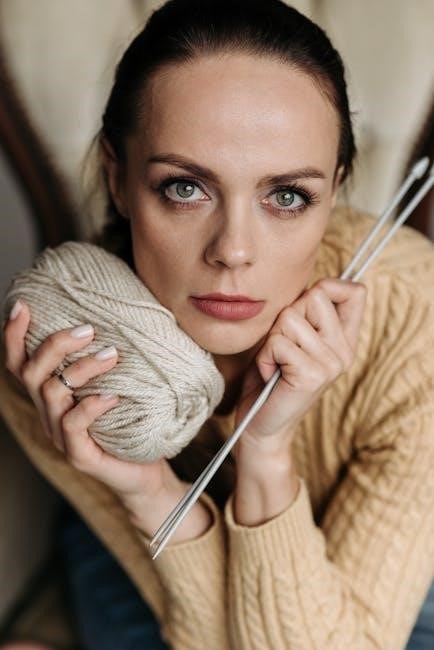
Knitting Tools and Materials
Essential tools include knitting needles (straight, circular, or double-pointed) and high-quality yarn, available in various fibers like wool, cotton, and blends, ensuring desired texture and durability;
4.1 Yarn Selection
Yarn selection is crucial in knitting, as it determines the texture, drape, and durability of the finished product. Choosing the right yarn involves considering factors like fiber type (wool, cotton, blends), weight (from lace to bulky), and color. Wool offers warmth and elasticity, making it ideal for sweaters and blankets, while cotton is perfect for lightweight, breathable summer projects. Blends combine benefits of different fibers, offering a balance of softness and strength. The yarn label provides essential information, including gauge, needle size, and care instructions, ensuring the best results for your knitting design.
4.2 Knitting Needles
Knitting needles are essential tools for bringing knitting designs to life. They come in various materials, such as aluminum, wood, or plastic, each offering different benefits. Straight needles are ideal for flat knitting, while circular needles are perfect for projects like sweaters or hats that require working in the round. Double-pointed needles are great for small, intricate designs like socks or gloves. The size of the needle, measured in millimeters or inches, must match the yarn and pattern to ensure proper tension and fabric texture; Choosing the right needles can significantly impact the speed and enjoyment of your knitting experience.

Step-by-Step Instructions
Step-by-step instructions are crucial for mastering knitting designs. They guide through essential techniques, tutorials, casting on, binding off, and following patterns, suitable for all skill levels easily.
5.1 Casting On
Casting on is the first step in knitting, where stitches are created on the needles. It sets the foundation for your project, ensuring even tension and proper fit. Various methods exist, such as the long-tail cast-on or the knit-on cast-on, each suitable for different yarns and patterns. Clear instructions guide you through creating the desired number of stitches, while tutorials often include video demonstrations to help master the technique. Proper casting on prevents issues like tight or loose starts, ensuring a smooth knitting process from the very beginning.
5.2 Binding Off
Binding off securely fastens the final stitches, completing your knitting project. The basic bind-off method involves knitting the first stitch, passing the second over it, and repeating until one stitch remains. Patterns often specify techniques like the stretchy bind-off for sweaters or the three-needle bind-off for seaming. Tutorials emphasize maintaining even tension to prevent a too-tight or loose edge. Step-by-step guides and video instructions help ensure a polished finish, while tips address common issues like puckering or unevenness, ensuring your project looks professional and maintains its shape, whether it’s a scarf, hat, or complex garment.
5.3 Following a Pattern
Following a knitting pattern requires careful attention to detail to achieve the desired result. Patterns provide step-by-step instructions, including stitch counts, row numbers, and specific techniques. Understanding abbreviations and symbols is crucial, as they represent stitches and actions. Begin by reviewing the materials list and gauge information to ensure proper fit and texture. Highlight or bookmark key sections to stay organized. For complex patterns, consider breaking them into smaller sections or using markers to track progress. Stay focused, and don’t hesitate to refer back to tutorials if confused. Patience and precision ensure a flawless finish, making pattern-following a rewarding skill for knitters of all levels, from beginners to experts.
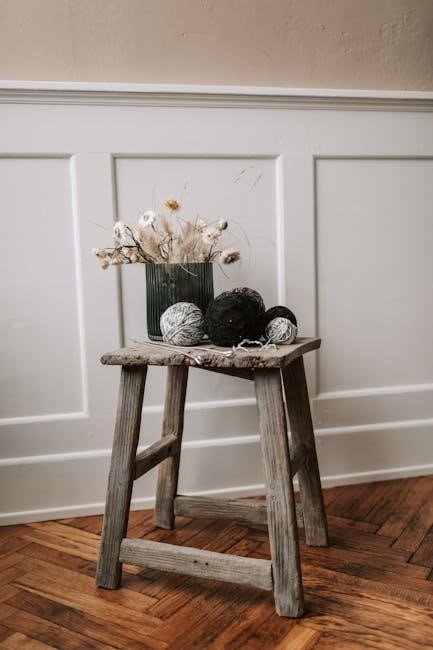
Popular Knitting Patterns
Popular knitting patterns include blankets, scarves, hats, and sweaters, offering step-by-step instructions for various skill levels. These designs combine creativity with practicality, ensuring enjoyable and rewarding projects.
6.1 Blanket Knitting Patterns
Blanket knitting patterns are timeless favorites, offering cozy and creative projects for crafters of all skill levels. These designs often feature simple yet versatile stitches, allowing for personalized touches like color variations or texture combinations. Many patterns include step-by-step instructions, making them accessible to beginners while still appealing to experienced knitters. From patchwork designs to intricate cable knits, blanket patterns provide endless possibilities for customization. They are perfect for gifting or adding a handmade touch to home decor. With a wide range of styles available, blanket knitting patterns cater to diverse tastes and preferences, ensuring a rewarding and enjoyable crafting experience.
6.2 Scarf and Hat Knitting Patterns
Scarf and hat knitting patterns are popular choices for crafters, offering quick and stylish projects to enhance any wardrobe. These designs often feature simple stitches, making them ideal for beginners, while still allowing room for creativity. Many patterns include step-by-step instructions, ensuring ease of completion. Scarf patterns may incorporate cables, lace, or texture, while hats often highlight ribbing or Fair Isle techniques. Both accessories are perfect for experimenting with yarn types and colors, enabling personalized finishes. Whether for personal use or as gifts, scarf and hat patterns provide versatile and practical knitting options, combining functionality with fashionable flair.
6.3 Sweater Knitting Patterns
Sweater knitting patterns are a favorite among crafters, offering detailed instructions for creating cozy, stylish garments. From bulky, textured designs to sleek, fitted styles, these patterns cater to diverse tastes and skill levels. Many include step-by-step guides, ensuring clarity for beginners, while advanced techniques like cables or Fair Isle knitting appeal to experienced makers. Sweaters can be customized with various sleeve lengths, necklines, and yarn types, allowing for personalized finishes. Whether you prefer oversized comfort or tailored fits, sweater patterns provide endless possibilities, making them a rewarding and practical knitting project for all seasons.
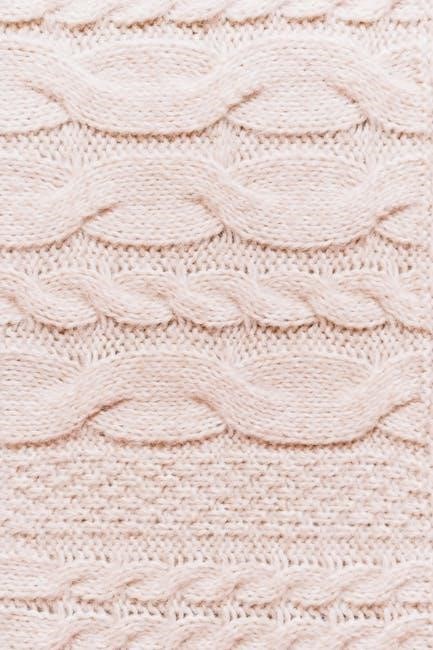
Knitting for Beginners
Knitting for Beginners is an ideal starting point, offering easy-to-follow patterns and clear instructions for crafting simple yet rewarding projects, perfect for new knitters.
7.1 Easy Knitting Projects
Easy knitting projects are perfect for beginners, offering simple yet rewarding designs. Start with scarves, hats, or headbands, which require basic stitches and minimal shaping. Dishcloths and baby blankets are also great options, teaching fundamental techniques like garter stitch and casting on. These projects build confidence and skills, allowing new knitters to progress gradually. Many free patterns include step-by-step instructions, ensuring clarity and ease. With practice, beginners can master essential knitting skills and create beautiful, functional items for themselves or as gifts. These projects are ideal for learning the basics while enjoying the creative process of knitting.
7.2 Learning Knitting Basics
Mastering knitting basics is essential for every beginner. Start by selecting the right yarn and needles for your project. Understand basic terminology and practice fundamental stitches like the garter stitch and stockinette stitch. Casting on and binding off are crucial techniques to learn first. Online tutorials and step-by-step instructions provide clear guidance. Begin with simple projects like scarves or dishcloths to build confidence. Join knitting communities for support and tips. With patience and practice, you’ll quickly progress from basic stitches to more complex patterns, unlocking a world of creative possibilities in knitting.
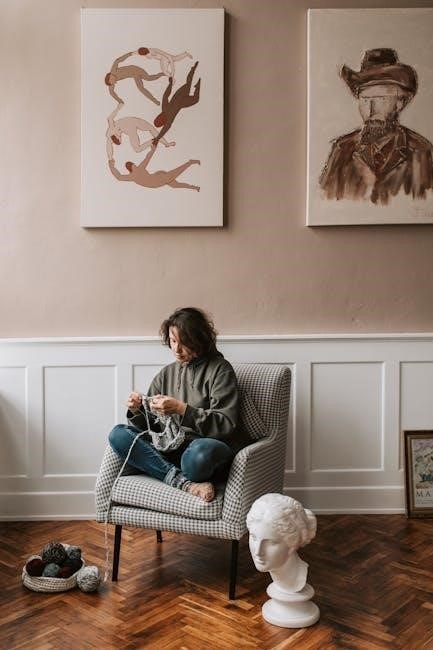
Knitting Resources
Explore knitting communities, forums, and websites offering free patterns, tutorials, and tips. Purl Soho, Yarnspirations, and AllFreeKnitting provide extensive libraries of designs and step-by-step guides for all skill levels.
8.1 Free Knitting Patterns Online
Discover a wealth of free knitting patterns online, perfect for crafting blankets, scarves, hats, and sweaters. Websites like Purl Soho and Yarnspirations offer step-by-step instructions and video tutorials. AllFreeKnitting provides a vast library of patterns for all skill levels, from beginner-friendly projects to complex designs. These resources often include detailed stitch guides and material lists, ensuring clarity for every project. Whether you’re making home decor items or clothing, free online patterns make knitting accessible and enjoyable. Explore these platforms for inspiration and guidance to create beautiful, handmade textiles with ease.
8.2 Knitting Communities and Forums
Knitting communities and forums are vibrant spaces where crafters connect, share ideas, and solve challenges. Platforms like The Knitting Circle and AllFreeKnitting foster collaboration, offering forums, galleries, and expert advice. These communities provide emotional support, tips, and inspiration, helping knitters refine their skills. Whether you’re troubleshooting a pattern or seeking feedback, these groups are invaluable. Many platforms also host challenges and events, encouraging creativity and growth. Joining a knitting community can enhance your crafting journey, offering a sense of belonging and endless opportunities to learn and grow as a knitter.
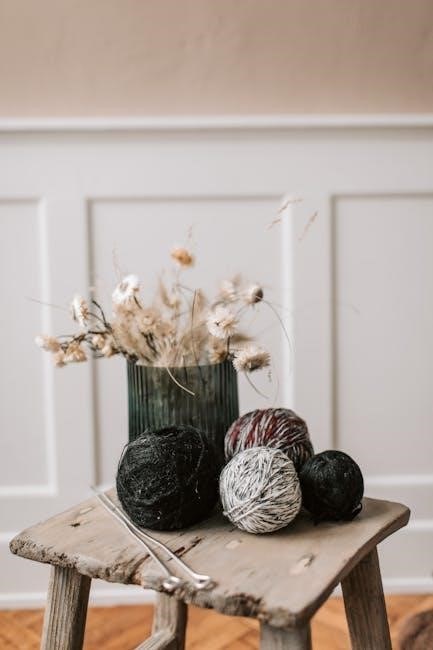
Knitting Tips and Tricks
Essential tips include measuring gauge accurately, using stitch markers, and swatching to ensure fit. Customizing patterns and avoiding common mistakes enhance your knitting experience and results.
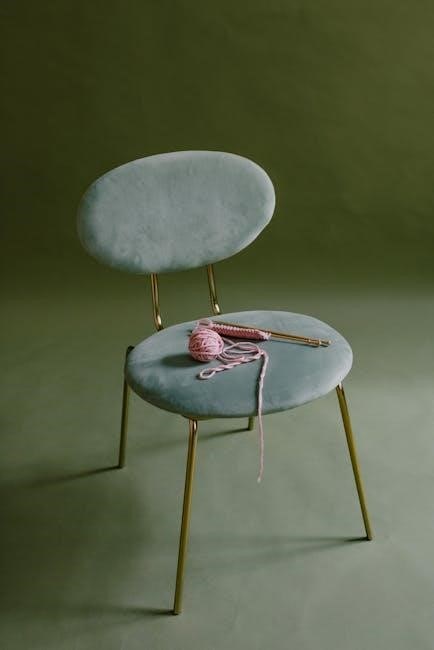
9.1 Avoiding Common Mistakes
Common knitting mistakes include incorrect gauge, miscounted stitches, and improper needle size. To avoid these, swatch before starting, use stitch markers, and double-check patterns. Tension issues can lead to misshapen garments, so maintaining consistency is key. Dropped stitches can be prevented with careful tracking, while yarn tails should be secured early to avoid unraveling. Regularly reviewing work and using lifelines can help catch errors early. Properly blocking finished pieces ensures professional results. These tips ensure smooth knitting experiences, helping you achieve flawless designs with minimal frustration.
9.2 Customizing Patterns
Customizing knitting patterns allows you to tailor designs to your preferences, ensuring a perfect fit and personal style. Start by adjusting measurements, sleeve lengths, or neckline shapes. Experiment with yarn colors or weights to transform the look. Modify stitch patterns or cables for unique textures. For beginners, small changes like adding buttons or embroidery can make a big impact. Advanced knitters can alter garment silhouettes or integrate complex motifs. Detailed instructions and stitch guides make customization accessible. With creativity and confidence, you can turn any pattern into a one-of-a-kind piece that reflects your individuality and skill level.
Knitting designs with instructions offer endless creativity and joy, providing clear guides for crafters of all levels to create beautiful, functional pieces that inspire and delight.
10.1 Final Thoughts on Knitting Designs
Knitting designs with instructions are a vibrant gateway to creativity, offering a wealth of patterns for all skill levels. From cozy blankets to stylish sweaters, these designs inspire crafters to explore endless possibilities. With clear step-by-step guides, anyone can master the craft, turning yarn into beautiful, functional pieces. The availability of free patterns and supportive communities makes knitting accessible and enjoyable. Whether you’re a beginner or an experienced knitter, these designs foster creativity and joy, allowing you to craft meaningful items that bring warmth and happiness to everyday life. Knitting is more than a hobby—it’s an art form that connects people worldwide.
